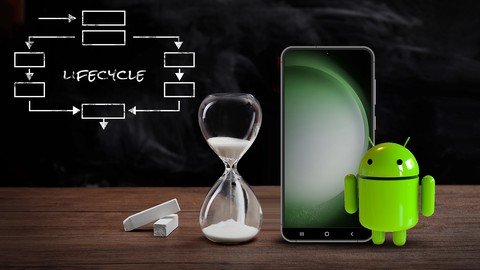
Published 11/2023
MP4 | Video: h264, 1920×1080 | Audio: AAC, 44.1 KHz
Language: English | Size: 5.70 GB | Duration: 8h 42m
Understand and leverage the lifecycles of the core components in Android applications!
What you’ll learn
Understand what Android lifecycles are and why they’re needed
Learn the lifecycles of the main Android components (Application, Activity, Fragment, etc.)
Handle configuration changes and process death in Android applications gracefully
Hack Android lifecycles when there is no other choice
Requirements
Minimal Android development experience
Description
As an Android developer, you’re aware that Android applications are built atop several core components with lifecycles, like Activities and Fragments. These components and their lifecycles are crucial for seamless integration with the Android OS and play a pivotal role in managing your app’s behavior.However, the intricate nature of Android lifecycles often leads to confusion and bugs, posing a significant challenge even for experienced developers. This course is meticulously crafted to demystify these complexities, empowering you with confidence and expertise.What You’ll Learn:Foundation of Android Lifecycles: Unpack the basic concepts and build a solid understanding of how Android lifecycles operate.Deep Dive into Key Lifecycle Elements:Process and Application LifecycleActivity LifecycleFragment LifecycleDealing with Configuration ChangesViewModel LifecycleStrategies for Save & Restore scenarios (Process Death)Lifecycle Management Best Practices: Learn the “standard” approaches to manage lifecycles efficiently and effectively.Advanced Techniques & Hacks: Beyond the basics, explore innovative hacks and ad-hoc solutions for unique lifecycle challenges.Real-world Application: Equip yourself with practical skills to tackle complex situations in your Android projects.Ace Your Interviews: Gain the confidence to answer lifecycle-related questions during job interviews.This course not only clarifies the fundamental concepts but also provides insights into the core architecture of Android, preparing you for advanced development tasks. Explore the full course syllabus, watch the sample lectures, and join me on this journey to mastering Android lifecycles. Welcome aboard!
Overview
Section 1: Introduction
Lecture 1 Introduction
Lecture 2 Review System
Section 2: Application Lifecycle
Lecture 3 Application
Lecture 4 Process
Lecture 5 Process Lifecycle
Lecture 6 Application Class
Lecture 7 Global Objects
Lecture 8 Application.onCreate()
Lecture 9 Application Lifecycle Summary
Section 3: Activity Lifecycle
Lecture 10 Activity Lifecycle
Lecture 11 Activity as Context
Lecture 12 Activity onCreate() and onDestroy()
Lecture 13 Activities Back Stack
Lecture 14 Activity onStart() and onStop()
Lecture 15 Activity onResume() and onPause()
Lecture 16 Overlapping vs Non-Overlapping Lifecycle States
Lecture 17 Multi-Resume
Lecture 18 Memory Leaks
Lecture 19 Activity Lifecycle Callbacks
Lecture 20 Activity Lifecycle Summary
Section 4: Fragment Lifecycle
Lecture 21 Fragment Lifecycle
Lecture 22 Fragment Code Review
Lecture 23 Fragment onCreateView() and onDestroyView()
Lecture 24 Fragment onViewCreated()
Lecture 25 Fragment onCreate(), onStart() and onResume()
Lecture 26 Fragment Lifecycle Demonstration
Lecture 27 Fragments Back Stack
Lecture 28 Activity – Fragment Lifecycle Coupling
Lecture 29 Fragment View Lifecycle
Lecture 30 Fragment View Recreation Optimization
Lecture 31 Fragment onAttach() and onDetach()
Lecture 32 Fragment Lifecycle Callbacks
Lecture 33 Fragment Navigation Libraries
Lecture 34 Fragment Lifecycle Summary
Section 5: Configuration Changes
Lecture 35 Configuration Changes
Lecture 36 Configuration Changes Demonstration
Lecture 37 Configuration Changes Mechanics
Lecture 38 Fixing Background Detection Code
Lecture 39 FragmentManager During Configuration Changes
Lecture 40 Views During Configuration Changes
Lecture 41 Custom State During Configuration Changes
Lecture 42 Custom State During Configuration Changes – Part 2
Lecture 43 Manual Handling of Configuration Changes
Lecture 44 Deprecated APIs
Lecture 45 Configuration Changes Summary
Section 6: ViewModel Lifecycle
Lecture 46 ViewModel Lifecycle
Lecture 47 ViewModel Demonstraion
Lecture 48 Observable ViewModel
Lecture 49 LiveData
Lecture 50 ViewModel onCleared()
Lecture 51 ViewModel Lifecycle Summary
Section 7: Save & Restore (Process Death)
Lecture 52 Save & Restore (Process Death)
Lecture 53 Memory Management in Android
Lecture 54 Testing Save & Restore Scenario
Lecture 55 Background Process Limit
Lecture 56 Stopping Cached Process
Lecture 57 Killing a Process From ADB
Lecture 58 Save & Restore in Activities
Lecture 59 Save & Restore in Fragments
Lecture 60 Save & Restore in ViewModel
Lecture 61 Save & Restore in Global Objects
Lecture 62 How to Support Save & Restore in Global Objects
Lecture 63 Save & Restore and Mutable Static State
Lecture 64 Save & Restore vs Configuration Changes
Lecture 65 Save & Restore (Process Death) Summary
Section 8: Course Summary
Lecture 66 Course Summary
Android developers of all levels
Password/解压密码www.tbtos.com